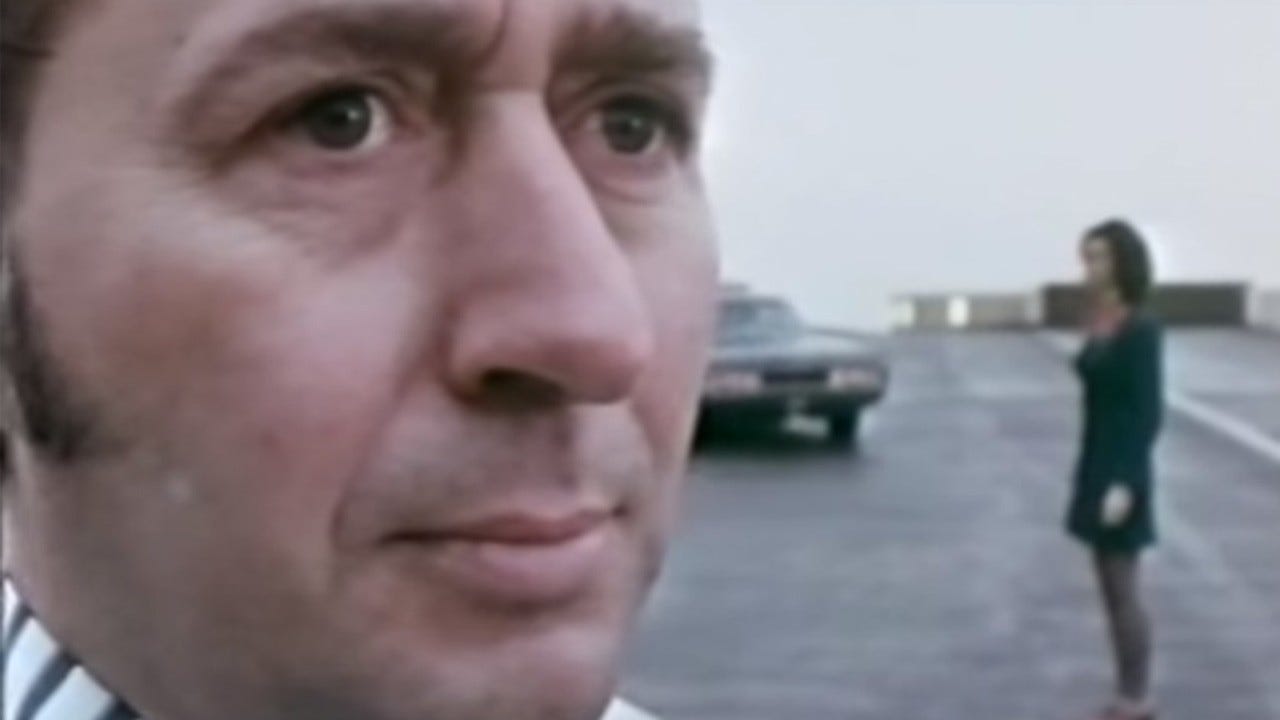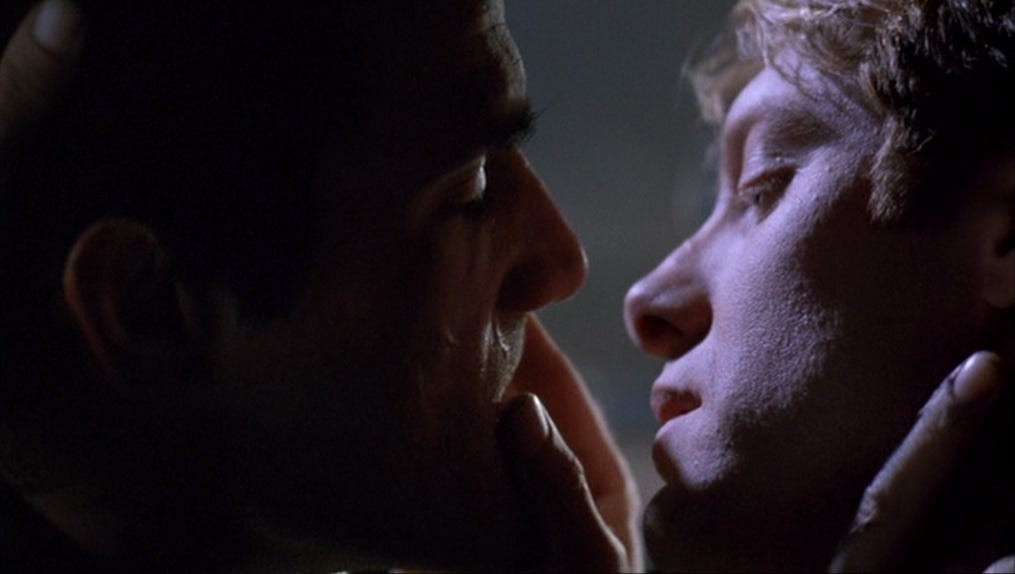Always Crashing: The Benevolent Psychopathology of Crash
J explores the modern relevance of David Cronenberg's ever-controversial 1996 classic, Crash.
This one has been on our minds for a long time. Not because of the sex, but because of the cars. We swear. Way back in the mists of 2023, when we were a group of five, there was a fateful session of brainstorming in which we decided that we simply must show David Cronenberg’s adaptation of J. G. Ballard’s controversial novel, the even more controversial Crash. Not only does it just epitomise Cinelogue as a group (hot, perverse and always causing moral outrage), but the idea of screening it always seemed naughty, just watching it feels like breaking an unwritten rule, but putting on in a cinema - Lewes Depot Cinema, no less - feels like getting away with murder. So when, at the very end of 2024, we started to plan our first screening in our new era, we had another brainstorming session, or that’s what it was meant to be… Crash was idly mentioned, and just like a collision, the next thing we knew we were searching for the screening rights and planning our prophetic steering wheel tattoos. Whilst there was some impish desire to put this film on a Depot screen that drove this programming choice (no pun intended), one of the things that makes it such an alluring pick is the story’s continued and enduring relevance, since the novel’s publication in 1973, to the film’s release in 1996 and to our screening in 2025. It’s a tale about many things, admittedly a tough one to crack initially, its steely surface needing a full force blow even to dent its side, revealing that perhaps there isn’t as much underneath as one might hope, revealing that this film and its source material are not metaphor but merely extreme satirisation of omnipotent psychosexualities that exist within us all already. Whilst I’m not going to accuse anyone I know of Vaughan level obsession, it’s interesting to notice the inseparable relationship to technology that the human race now possesses.
Towards the end of 2023, I had an encounter that has stuck in my mind. I was sitting on the bottom deck of a double-decker bus in the middle of the day, listening to music and watching the world go by. There were cars and other buses zipping past us as we drove around a roundabout on the main road that ran through town. I was lost in my music, just seeing colours as they moved past me. It was at this point that I noticed that beside the bus, just next to me on the other side of the glass, was a motorcycle, and, as I noticed a few moments later, a motorcyclist too. It was a real double-take moment, really taking me a good few seconds for my brain to process that what I was seeing was both cycle and cycler. The whole thing, bike and rider, was a matte silver, an industrial slick form, the bike clearly designed in such a way that whoever sat atop it would slot in like a puzzle piece, seemingly with matching riding garments designed alongside the vehicle, man and machine designed as one, a fusion of metal and flesh out in the wilds for all to see. I say man meaning human being, because whoever was riding this bike was androgynised by the bike, clothing and helmet. This was one being to me for a short time, human-bike fusion.
Coincidentally, not long before this encounter, I had watched Harley Cokeliss’ Crash!, a 1971 adaptation of a J.G. Ballard’s short story (also titled Crash, which appears in The Atrocity Exhibition), which I had also recently read. Cronenberg’s Crash has been a personal favourite of mine for quite some time, and I had been on something of a deep-dive of the story at that point - after seeing the film for the first time a couple of years before, I had always known that I enjoyed the film, but I’m not sure I ever fully got it. Who can blame me? There’s a lot to take in. Since that initial viewing, I’ve become a little more at ease with ‘vibe’ films, where lots of stuff happens but those specific plot points themselves aren’t the meaning, the allegory itself is in the circumstance - i.e. car crash sex parties, not specifically Vaughan and co.’s car crash sex parties. Whilst the film clearly manages to speak for itself, I would implore anyone who hasn’t had the displeasure of reading J.G. Ballard’s novel and short story to give them a go; it’s truly a singular vision and can get away with a lot that a mainstream studio picture couldn’t… Ballard’s vision of Crash is a lot bleaker (perhaps being set in London helps) and is written with such a relentlessly graphic register that does not hold back on any detail. Blood, machinery and sex are centre-stage, creating a disgustingly alluring piece of literature that makes the themes of human-machinery fusion so obvious that it’s hard to ignore - sometimes because plot is secondary to the very meaningful shock factor. Cokeliss’ film, at only 17 minutes, is a lot more direct about this, using voiceover to detail the beauty of cars that are designed for their drivers - putting the driver/machine to the forefront of the piece in a way that bridges Ballard’s book to Cronenberg’s film beautifully.
In Cronenberg’s 2022 film Crimes of the Future, it is posited that “surgery is the new sex”, and in Crash, his characters become obsessed with “a benevolent psychopathology that beckons towards us”, that psychopathology being a freeing sexuality intrinsically tied to the thrill of bodily change at the hands of machinery that has far greater power than we could ever have. This machinery, automobilia, becomes an extension of our characters and their power, and cars themselves replace sex, sexual desire becoming car chases and the crash itself becoming a twisted metallic climax. Whilst in Cronenberg’s filmic chronology, Crimes of the Future comes after Crash, the evolving and changing ideas of sex and bodily alteration becomes a window into our very beings - and perhaps into our not so distant future.
Thinking back to the motorcyclist I saw in 2023, and how they had all but physically fused with their motorbike, I realised how accurate Crash’s prophecy was, that the benevolent psychopathology has beckoned to humanity and humanity has listened. When I really thought about our relationship with technology, I realised that this encounter I had was so reflective of Crash, but that it reaches far beyond that. Ballard (and Cokeliss and Cronenberg subsequently) satirised the reality that technology has found its way into every orifice of our lives. Crash takes it to the extreme, but I can’t help but feel it is based on some kind of truth - if autoerotic asphyxiation does the right things for some people, surely autoerotic automobile accidents are not such a stretch? Similarly to how generation Z have been desensitised to on-screen violence by the media they ingest being more extreme than what previous generations have had access to, and how the silent generation was appalled by what was being put into the films that baby boomers enjoyed during the New Hollywood of the ‘70s - is Crash accurately fortelling our relationship with machinery escalating to the extreme? Technology has found its way into our entertainment, our food preparation, our sleep, social lives and sex, and many people rely on these technologies to fully function in an intertwined co-dependence of technological and human extremity that fuels itself to new territory.
In a similar vein to Cronenberg’s Videodrome, which satirises the increasing media violence that has since been trumped ten times over by real life, the saturation of violence and new technologies that we are exposed to on a day-to-day basis converge within Crash. In a sickeningly credible collision of sadomasochistic desires for extremities, it’s entirely plausible that the future the film proposes is not too far away, one in which the motorcyclist becomes one with their vehicle in an aesthetic, and perhaps even sexual, way. Whilst I’m projecting this nightmarish speculation onto the poor unwitting driver I saw a year and a half years ago, who is most likely getting on with their own life without even considering a hook-up with their motorbike, let alone a violent one, I think it’s worth really dissecting Ballard’s story through an especially Cronenbergian lens that looks at the story from a different perspective, one that sees it as somewhat of a utopia, if only to save the poor member of the public from being turned into a representation of reprehensible moral corruption…
At one point in Crash, Vaughan, as played by Elias Koteas in Cronenberg's film, tells Ballard (the character) that his attraction to cars and road accidents come from an interest in the ‘reshaping of the human body’. This could be interpreted as the change that occurs in a life-altering crash, or as the reshaping and/or modification of the body through the technological extension by automobiles that finds itself in sharper focus within Cokeliss’ adaptation. Through this lens, the crashing cars that are subject to such sordid eroticism throughout the film themselves become the bodies of the characters, a neofuturist vision of cyborgian lifestyle in which fleshy sex organs have become indecipherable from their metal counterparts; exhaust pipes, gearsticks, fuel tanks and grilles. In a sense, bodies have become sexless, sexuality and gender have given way to the automobile - a psychopathically benevolent form that creates a debauched utopia of internally unprejudiced pleasure defined by the androgynous fusion of humanity and machinery.
Perhaps it would be controversial (and somewhat perverted and inherently disturbing) to suggest that Vaughan, Ballard and co. have a point - because they don’t, but within the story’s verisimilitude, the underground movement of car-fucking free-lovers represent something quite optimistic. In the darkness of the future, perhaps blasted by missiles and reduced to industrial hell by late-stage capitalism, there is hope in a group of misfits finding the space to rebel against their existence and engage in a subculture of consensual androgynous love. It’s a very Queer idea, so it naturally appeals to me, but to see that the pursuit of passion, human passion, persists through the trials of a technological nightmare, that love (as twisted as it might be) finds a way to pierce the steely surface, does evoke some warmth… It’s a dark way to be optimistic but it is this cold darkness that allows the characters of the story to live out their darkest fantasies behind smashed windscreens and on torn leather seats, it’s out of the ashes of a familiar society that this new culture emerges from, a wholly human tale of survival.
Perhaps the visions of Ballard and Cronenberg are farfetched, but it can’t be disputed that they are heavily based on some plausible version of what lies ahead. Will we ever stop caring? So much so that a benevolent psychopathology finally reaches us, that we really start testing the limits of our human form? The writing may be on the wall, but only time will tell…






